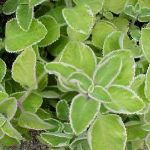| Common Name: |
Spanish Thyme |
| Other Names: |
Cuban Oregano, Indian Borage |
| Botanical Name: |
Plectranthus abnoinicus syn. Coleus amboinicus, C. aromaticus |
| Genus: |
Plectranthus |
| Family: |
Lamiacaea |
| Native Location: |
Unknown in the wild; possibly from Africa or India originally. |
| Cultivation: |
Light, rich, well-drained soil in sun. Provide ample moisture during the growing season but keep on the dry side in winter. Pinch out tips during the growing season to encourage bushy growth. Cut back straggly plants in spring. |
| Propagation: |
By seed sown at 19-24°C (66-75°F) when ripe; by stem-tip cuttings at any time, avoiding excessively damp conditions. |
| Harvest: |
Leaves are picked as required and used fresh. |
| Variations: |
Variegated
Has white-variegated leaves. |
Well-Sweep Wedgewood
Has pale green leaves with darker green margins. |
|
| Height: |
30-90cm (12-36in) |
| Width: |
30-90cm (12-36in) |
| Hardiness: |
Min. 10-15°C (50-59°F) |
| Parts Used: |
Leaves |
| Properties: |
A strongly aromatic, healing herb with an oregano-like flavor. It relaxes spasms, reduces inflammation, benefits the digestion, and has laxative, expectorant, and antibiotic effects. |
| Medicinal Uses: |
Internally for coughs, bronchitis, asthma, colic, dyspepsia, and postpartum pain. Externally for headache, sores, burns, and insect bites. |
| Culinary Uses: |
Leaves are used to flavor beans, salads, and strong-smelling meat and fish; also infused as tea. An ingredient of Vietnamese sour soup, canh chua, and the Indian salad, bajeh. |
| Bibliography: |
Encyclopedia of Herbs by Deni Brown Copyright © 1995, 2001 Dorling Kindersley Limited Pp 324 |

